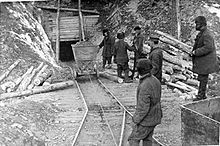Kolyma - Street of Bones
| Movie | |
|---|---|
| Original title | Kolyma - Street of Bones |
| Country of production | Germany |
| original language | Russian |
| Publishing year | 2017 |
| length | 85 minutes |
| Rod | |
| Director | Stanislaw Mucha |
| script | Stanislaw Mucha |
| music |
Eike Hosenfeld , Moritz Denis, Tim Stanzel |
| camera | Enno Endlicher |
| cut | Emil Rosenberger, Stanislaw Mucha |
Kolyma - Street of Bones is a documentary film by Polish director Stanisław Mucha (* 1970) from 2017. The documentary was made when Mucha drove around 2000 km along the R504 trunk road in Russia's Far East , which is also the "Street of Bones" (rarely : Road of Death ) is called. Its course largely corresponds to today's R504. Mucha wanted to trace the path that his father in 1952, in a Gulag - labor camps deported was, had to go.
content
The filmmaker Mucha embarks on a partially fictional journey through the Kolyma region in Siberia , one of the former centers of the Gulag, the Soviet prison system. On the R504 road, he follows in the footsteps of his grandfather, who was arrested as a spy, convicted under Article 58.6 and sent to the Gulag. Almost seventy years earlier, in 1952, he arrived in Magadan , only to be passed on to Yakutsk via the so-called “road of bones” by the victims . Between Magadan and Yakutsk, more than 2,000 kilometers apart, runs the road that was built between the 1930s and 1950s by forced laborers of the Gulag, who also work in gold , silver , uranium and other mines around the road under inhuman ones Conditions had to work (“victims of the Stalinist and post-Stalinist state paranoia”). Many lost their lives, along the road there are some human skulls and bones only 15 cm below the surface. "It is probably the longest cemetery in the world" with an estimated more than three million dead.
Stanisław Mucha also vividly portrays today's life along the road in the Kolyma region and documents his sometimes unreal experiences. In Magadan, the starting point of the “Street of Bones”, he meets a street vendor for whom the term “Gulag” has absolutely no meaning. Mucha indirectly criticizes, sometimes bizarre, the weak Russian culture of remembrance of the victims that the Stalinist camp system demanded.
documentation
The documentary is a co-production by TAG / TRAUM Filmproduktion, ZDF / 3sat and the Hessischer Rundfunk from 2017. It was produced by the Polish director Stanisław Mucha and was awarded as the best documentary film at the Achtung Berlin film festival in 2018 . It started in theaters on June 21, 2018. It was first broadcast on 3sat on October 7, 2019 and on Hessischer Rundfunk on January 16, 2020.
Individual evidence
- ↑ a b c Kolyma , review of the W-film portal, online at: wfilm.de / ...
- ↑ a b Kolyma - Straße der Bones (2017) , a film review by Harald Mühlbeyer, Portal Kino-Zeit, online at: kino-zeit.de / ...
- ↑ Kerstin Decker: On the way in the icy tip of Russia , Der Tagesspiegel, online edition, June 21, 2018, online at: tagesspiegel.de / ...
- ↑ a b Kolyma - Straße der Bones , short description of the station Hessischer Rundfunk, online at: hr-fernsehen.de / ...
- ↑ Kolyma - The Street of Bones , online at: programm.ard.de / ...
Web links
- Full-length film (video) at hr (84:37 min.)

